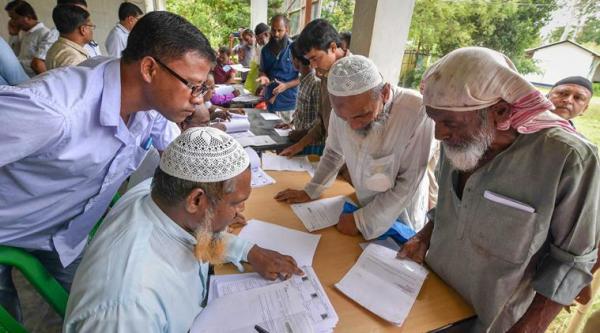A feeling of homelessness
Anti-NRC campaigns refuse to acknowledge that Assam’s indigenous people are losing land and economic space

The strident propaganda launched by some quarters against the updating process of Assam’s unique National Register of Citizens 1951, insinuating that this was a conspiracy to disenfranchise a huge number of Indians, forget that the upgradation is being carried out under the direction and supervision of the Supreme Court of India in a state that has long suffered from large-scale infiltration of foreign nationals.
It was decided to have an NRC for Assam after the 1951 census after it came to notice that large-scale illegal migration was taking place in the state. It was a far-sighted decision. Unfortunately, this exercise was abandoned in the subsequent censuses, presumably under the influence of vote bank politics. And illegal migration through the porous border continued. This created a situation in which the indigenous people of Assam were gradually losing their land and economic space, and further becoming almost politically irrelevant in their native land. The Assam Agitation took place in such a situation. Indian researchers have documented the migration problem and even an American researcher, Myron Weiner, discussed in detail Assam’s disturbing demographic change in his book, The Sons of the Soil. In 1987, the then Assam Governor Lt General S K Sinha had submitted a detailed and well-documented report to the President of India on the issue of illegal migration suggesting many measures to effectively prevent this undesirable situation. Unfortunately, successive governments ignored the well-meaning recommendations of the governor.
The draft of the full NRC was published on July 30, 2018. Despite the exercise being undertaken under the supervision of the apex court, a massive international campaign was carried out against the exercise even before the final draft was published in the name of human rights. It launched a signature campaign claiming it to be a conspiracy to deprive 70 lakh “Indian Muslims” of their citizenship equating the fate of this imaginary number to that of the Rohingya of Myanmar. Another campaign was carried out by some organisations and intellectuals from the Barak Valley to call it an exercise against the Bangla-speaking population of Assam.
Where do these two separate campaigns, issuing from two different socio-cultural registers, meet? They both are attempting to paint this exercise as conspiratorial on behalf of the indigenous people, who have ironically been at the receiving end of migration pressure on demography since the time of the British occupation of this region. The British encouraged continuous migration of the immigrants for making their occupation profitable. The trend continued and migration increased even after the partition of India. Successive ruling parties have found in the immigrants a vote bank. So through the successive census operations, demography continued to change in favour of the non-indigenous people with the alarming reduction of the original natives. History does not go back and the pre-British original natives of Assam cannot be expected to get back the comfortable position of absolute preeminence of the past. This is the lesson the Assam agitation has taught resulting in the compromise of Assam Accord. But the one thing the indigenous communities will not accept is being a minority in their homeland and be politically beholden to the immigrants, who may, in course of time, try to grab the major portion of the political cake. The anti-NRC campaigns are an attempt not only to communalise the exercise but also to cause an amnesia about the historical fact of continuous loss of political and economic space by the indigenous people.
The NRC is an exercise to ensure that genuine Indian citizens are not deprived of the entry of their names in the register and that those who entered India after March 24, 1971 from Bangladesh are not included in the same register. The acceptance of the entire stream of immigrants from the date of the independence of the country till March 24, 1971 is not only a recognition of the historical situation of the birth of Bangladesh, but for the autochthons, it is a big sacrifice of their interests and rights on their native soil.
Since the Supreme Court is overseeing the exercise, it must lend its weight to the preparation of a correct NRC. Entry of names in the NRC needs proof of some documents, which are many with alternatives, and everyone including the indigenous people have been required to collect and submit these documents. Everyone has taken a lot of pains to submit their proof of citizenship. If there is some mistake and if there is some mischief, all such aberartions have to be rectified during the ongoing process of submission of complaints and if it is found that any official is indulging in mischief, such official/s have to be taken to task according to procedure. Unfortunately, the ruling party by bringing in an amendment to the Citizenship Act to grant citizenship to illegal migrants of all religious communities barring the Muslims, has provided ammunition to international groups to paint a communal picture of the NRC document.
This exercise is not the end of the struggle of the indigenous communities to preserve their native identity. The Clause 6 of the Assam Accord has to be implemented to ensure constitutional safeguards for the future of these communities. Assam’s Commissioner of Home L S Changsan has said “a common database is being created with the objective to avoid confusion and overlapping”. This is welcome as it will help citizens from being subjected to undue harassment. Besides, the updating is not an one-time exercise. The citizens will have children, and so, there has to be a seamless process for updating the NRC in future to include the newborns. In future, the birth and death registration will have to be linked to the NRC database.
The writer is a former Director General of Police, Assam and the author of Prabrajan and Anuprabesh






































No hay comentarios:
Publicar un comentario